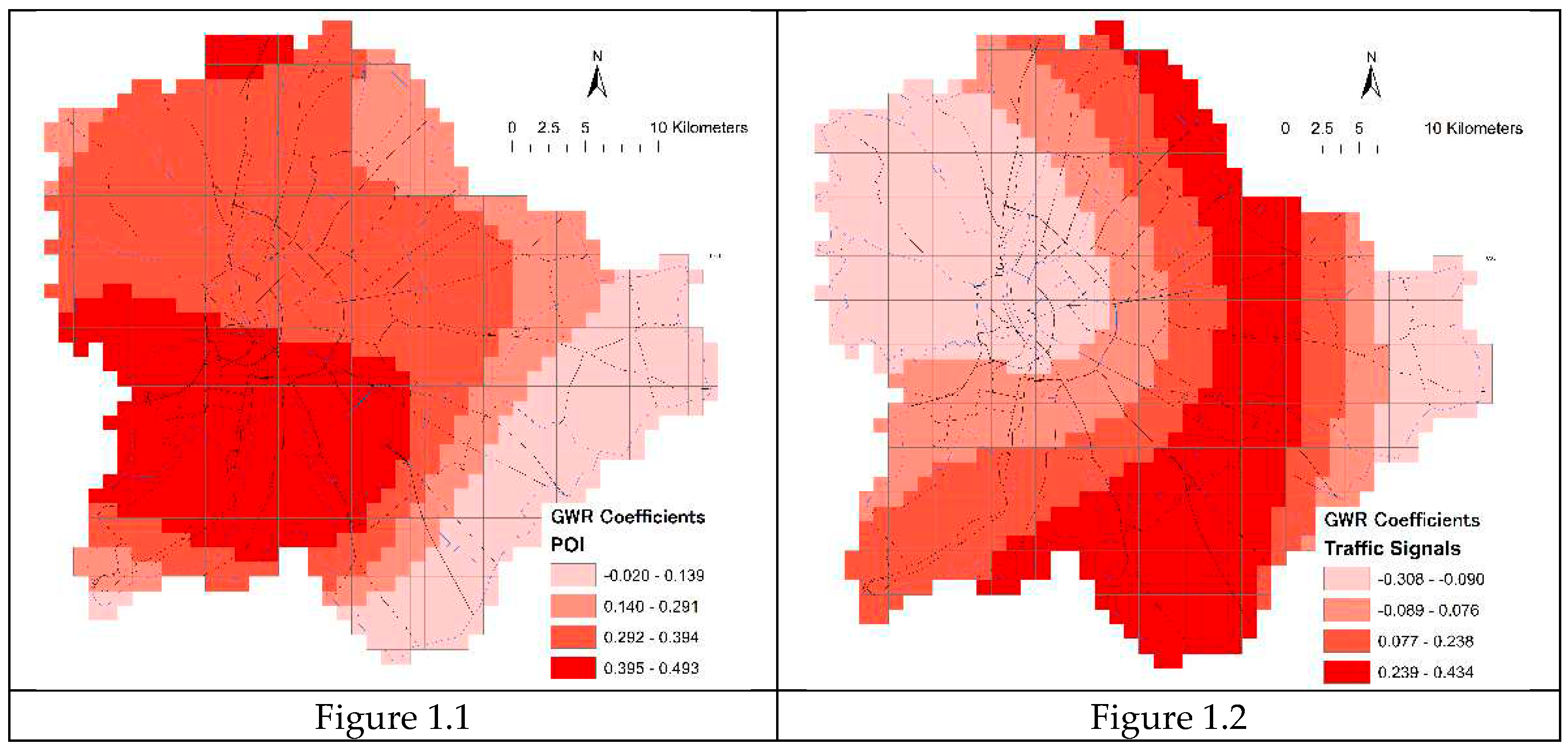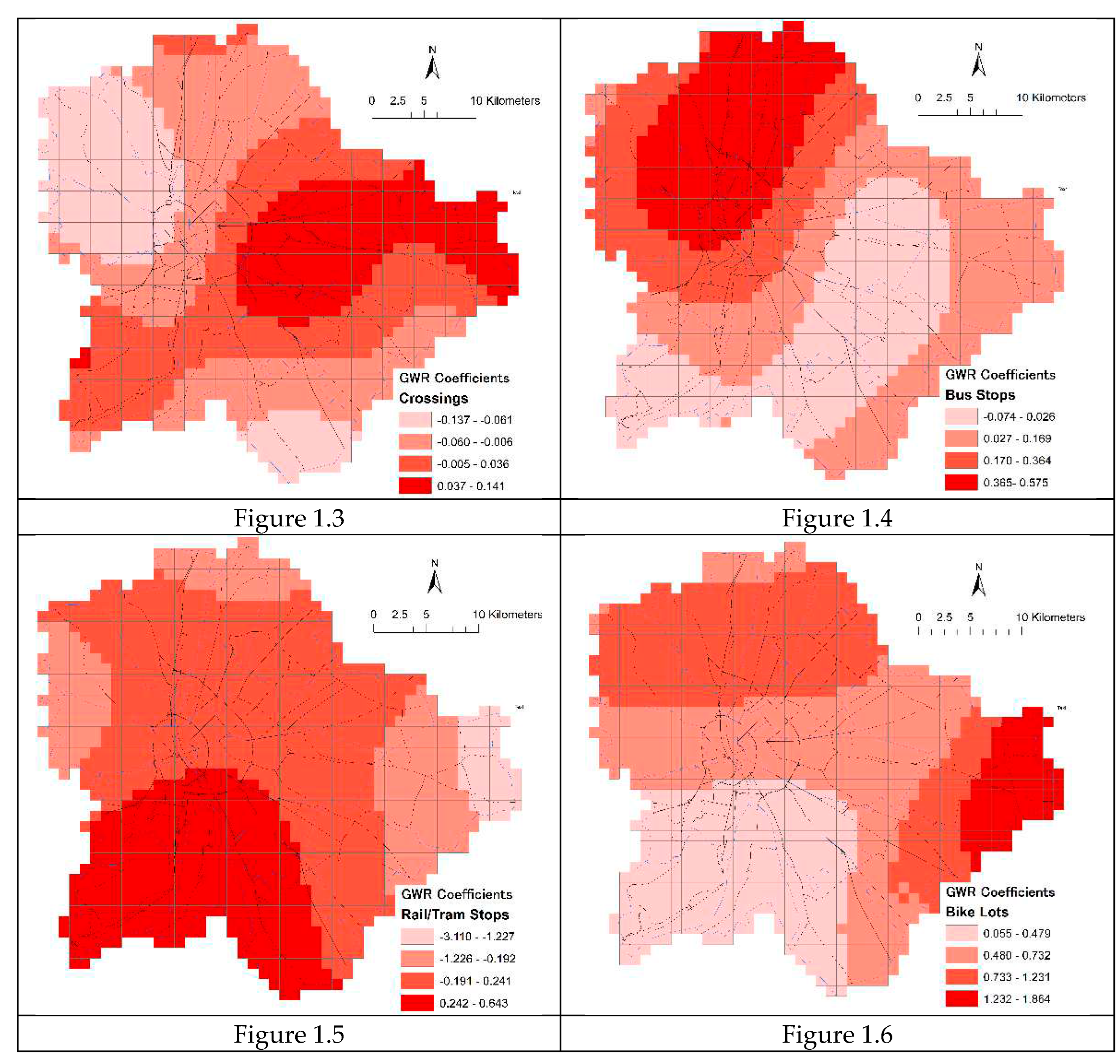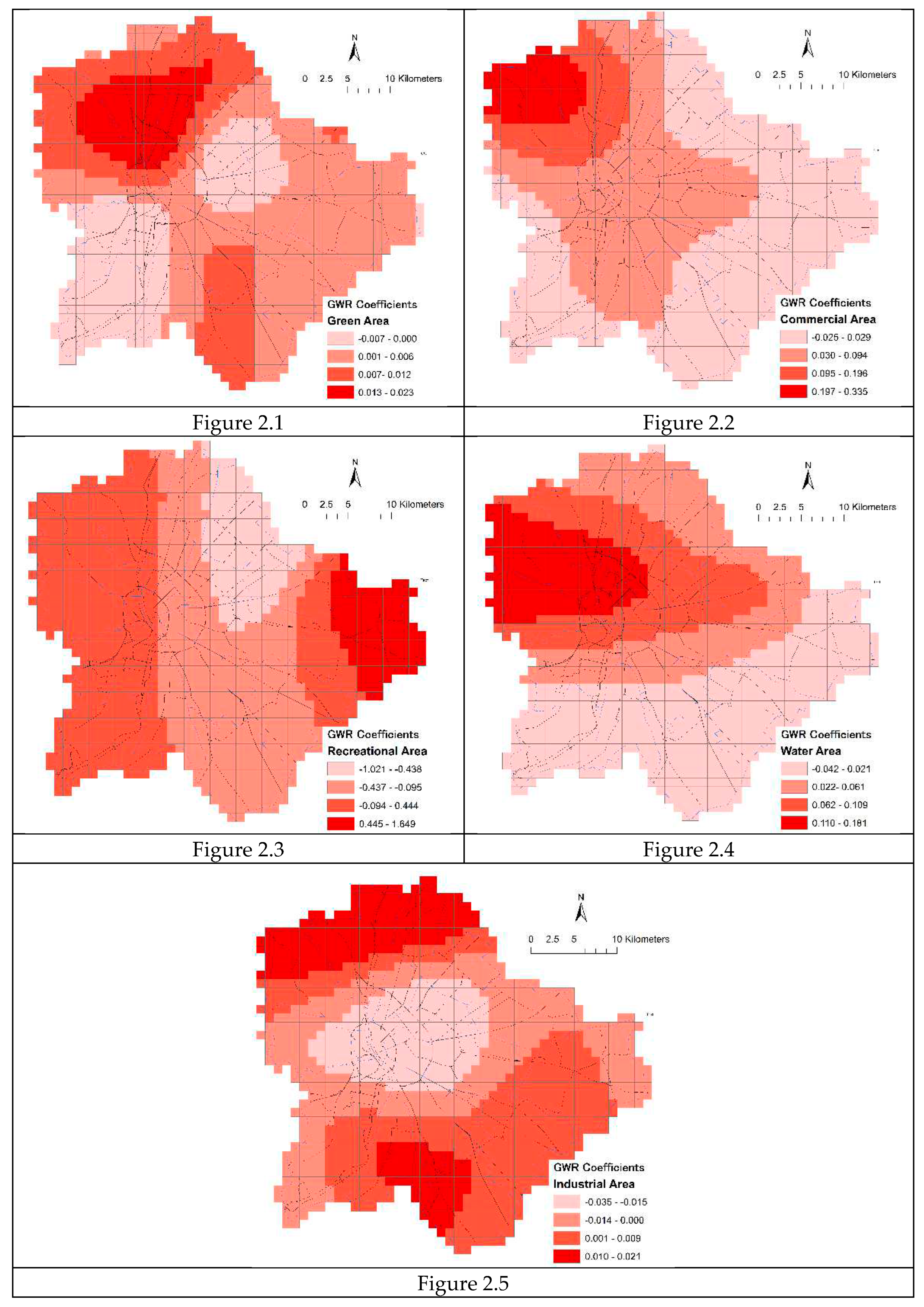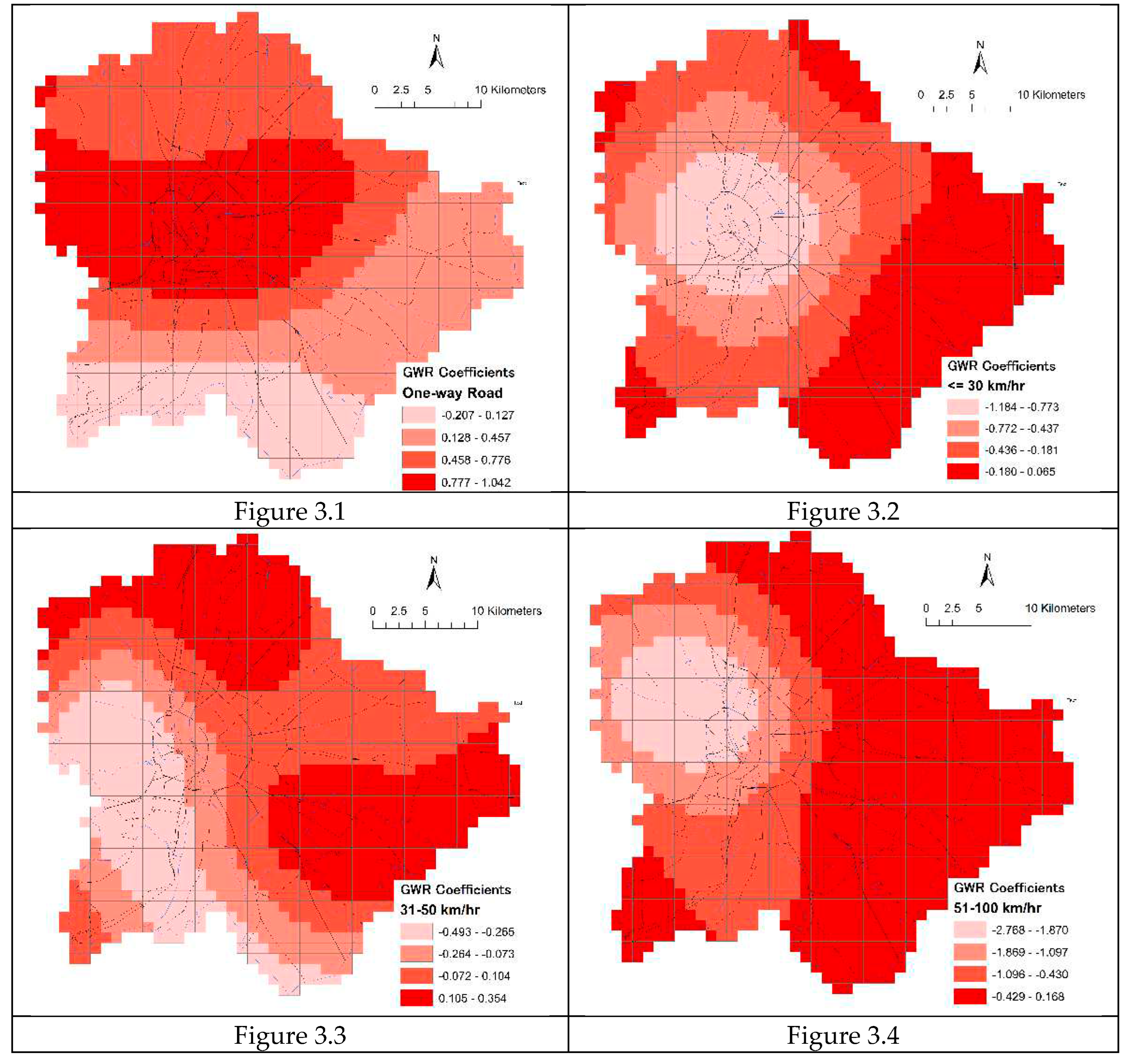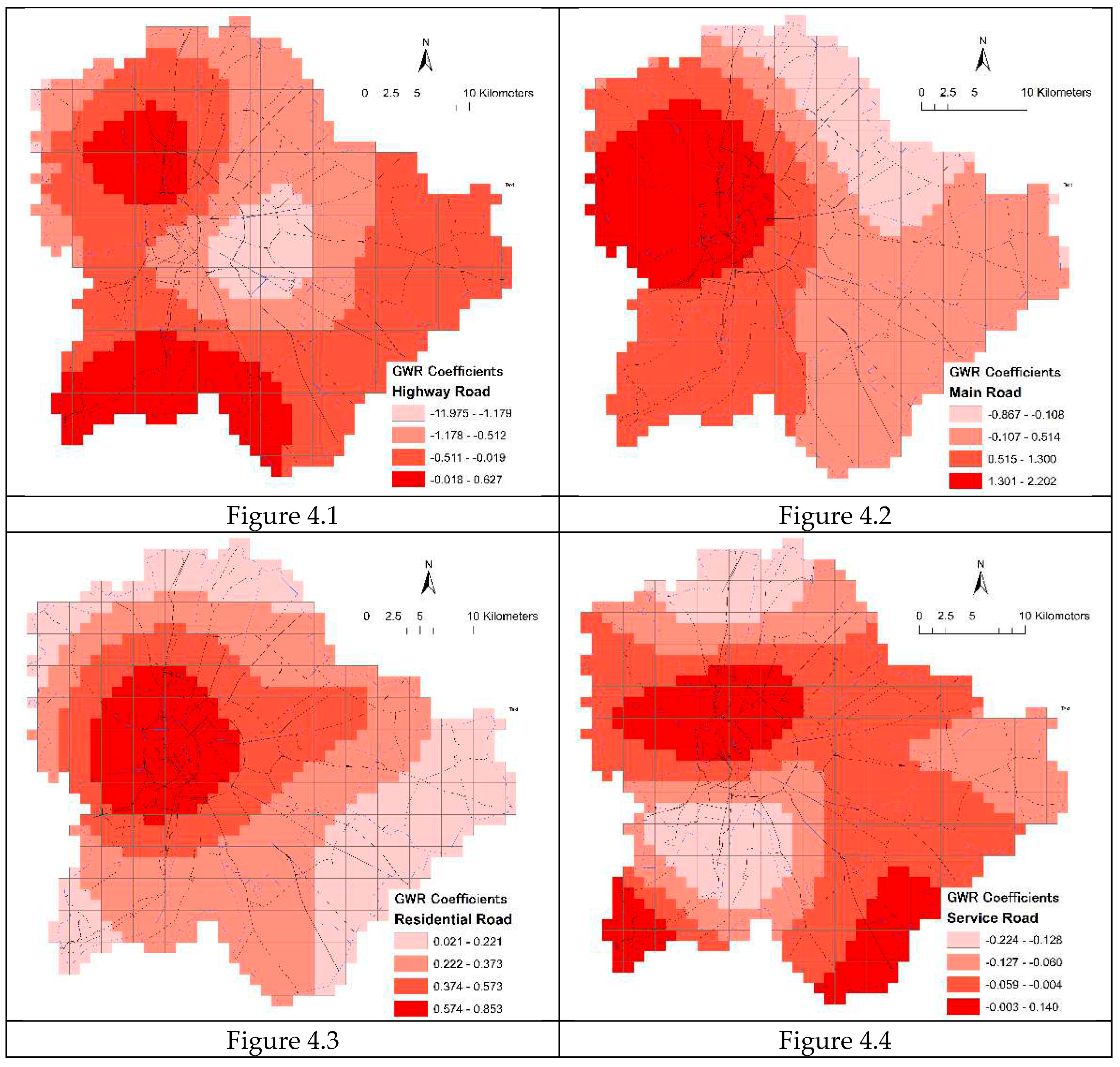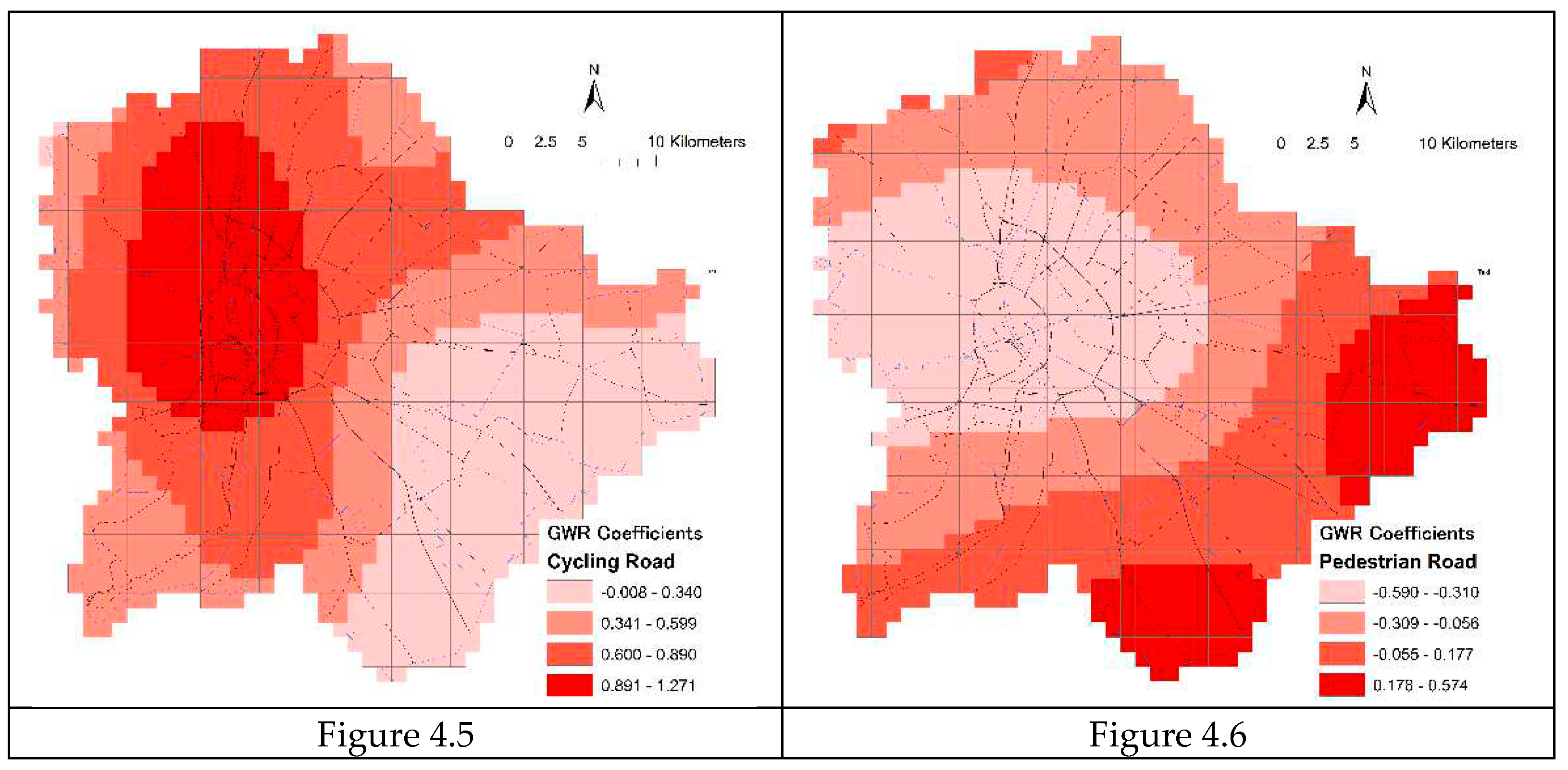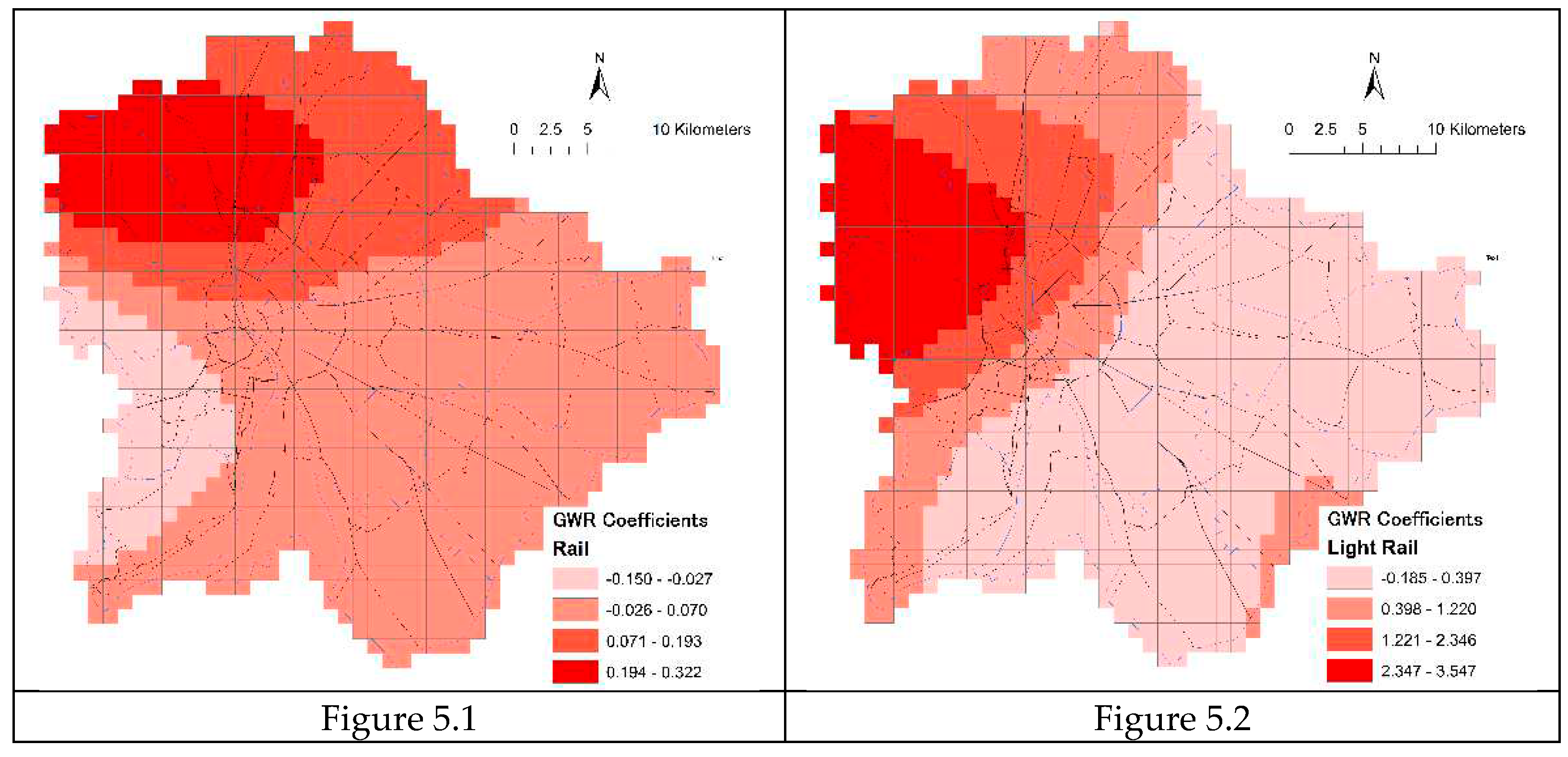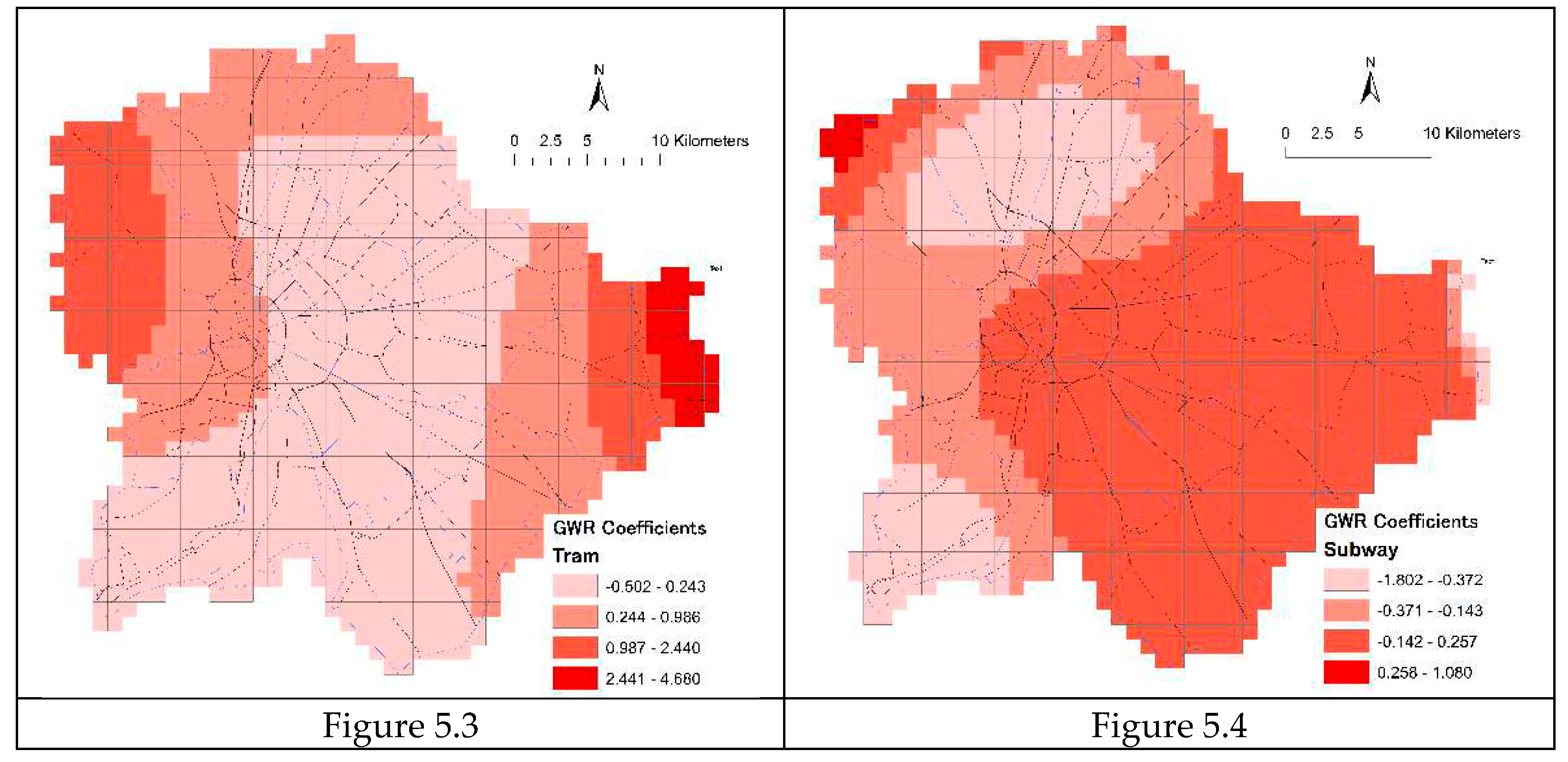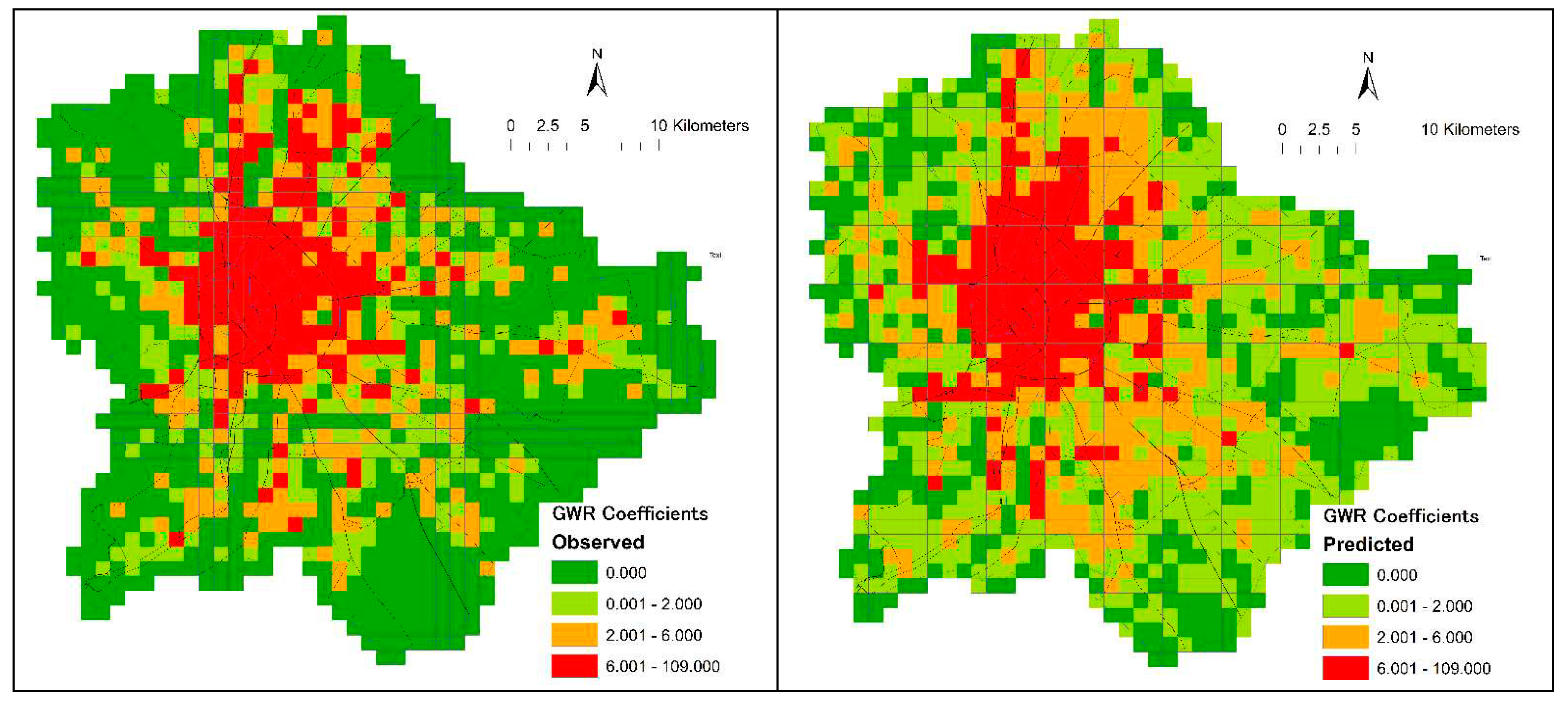1. Introduction
For its many positive effects on individual, public and environmental health [
1], cycling has become a common form of urban transportation in many cities around the globe [
2,
3]. However, cycling can also be risky, especially in congested urban areas where collisions with cars are frequent. City planners and policymakers can design safer transportation systems that prioritize the safety of all road users [
4]. This requires a deeper understanding of the factors affecting cycling crashes [
5].
Many factors, including the built environment, land use, and transportation network characteristics, influence cycling accidents [
6,
7,
8]. Cyclists are at a higher risk of injury or death on roads with higher speed limits, wider lanes, and heavier traffic [
9,
10]. Roundabouts, intersections, and bike lanes may affect the frequency of accidents involving cyclists [
11,
12]. When there aren't bike lanes at an intersection, for instance, cyclists must weave in and out of traffic to make turns, which can be dangerous. Land use also significantly influences cyclists' safety; bicycle accidents are more likely to happen in areas with a high population density, a variety of land uses, and lots of pedestrian traffic [
13,
14]. Furthermore, areas with high concentrations of cyclists and motorists can result in conflicts that lead to accidents [
15,
16]. Considering these threats when planning cities and neighborhoods helps to lessen the negative impact of cycling. Cities can encourage healthy and sustainable lifestyles by prioritizing cycling infrastructure and land use patterns that support active transportation and reduce the number of accidents involving cyclists.
The main contribution of this research is the definition of the spatial relationships between the bike crashes and the built environment, land use, and transportation network characteristics which can have significant impacts on the frequency and severity. The novelty of this study is that bike crashes have not been spatially studied using geographic weighted regression (GWR) in aspects of land use patterns, speed limits, roads classification, and rails network densities in urbanized area. GWR can provide insights into the spatial patterns of bicycle crashes and help policymakers identify high-risk areas and develop targeted interventions to reduce the severity of crashes.
2. Literature Review
Several studies have identified various factors that contribute to cycling crashes, including individual factors such as age, gender, and experience level [
17,
18,
19], and environmental factors such as road conditions and traffic volume [
20,
21]. Some studies found that elderly people had a higher risk of severe injuries in cycling crashes [
22,
23,
24]. Other studies identified road design and infrastructure as critical factors in cycling crashes, including the presence of dedicated cycling lanes and intersections [
25,
26,
27]. Traffic calming measures, and adequate lighting can significantly reduce the risk of cycling crashes [
28,
29,
30]. On the other hand, poor road conditions such as potholes, uneven surfaces, and inadequate signage can increase the risk of cycling crashes [
31,
32,
33]. In addition, the presence of barriers such as high curbs or fences can make it difficult for cyclists to navigate the road safely [
34,
35]. Designing cycling infrastructure that prioritizes the safety and needs of cyclists can reduce the risk of cycling crashes and make cycling a more accessible and attractive transportation mode.
Other important factor affecting cycling crashes is the behavior of cyclists and drivers. Several studies have found that risky behaviors such as cycling at high speed, running red lights, and lack of protective gear can increase the likelihood of cycling crashes severity [
36,
37,
38,
39]. In addition, drivers who are distracted, speeding, or under the influence of drugs or alcohol pose a significant risk to cyclists on the road [
40,
41,
42]. Education and awareness campaigns aimed at promoting safe cycling and driving behaviors can reduce the risk of cycling accidents [
43,
44].
Spatial factors also play a crucial role in cycling crashes. Some studies found that the risk of cycling crashes increased in areas with high traffic volume and high-speed limits, particularly in urban areas [
45]. Other studies also found that areas with high population density and high levels of economic activity were more likely to have cycling crashes, indicating a need for better urban planning and transportation policies [
46,
47].
Geographically Weighted Regression (GWR) is a statistical technique that has been increasingly used in transportation research to analyze the spatial patterns of transportation-related phenomena [
48,
49,
50], including crash severity analysis. To focus on the cycling crash severity analysis based on GWR, here are a summary of the literature review discussed this issue.
These previous studies in
Table 1 demonstrate the utility of GWR in modeling the severity of bicycle crashes. Clear gaps are extracted from the literature such as specific land use patterns as the industrial, water, commercial, recreational, and green area, as well as, speed limit, density of road and railway networks, which are the main novelty of our research.
3. Methodology
3.1. Framework
GWR is a local regression model that accounts for spatial heterogeneity in the relationship between the dependent variable and the independent variables. The technique involves estimating a separate regression model for each location or point in space, where the coefficients of the independent variables are allowed to vary spatially. The resulting local models can then be used to explore spatial variation in the relationship between the dependent and independent variables [
48,
55], and help to identify any spatial heterogeneity in the relationships that may be missed by a global regression model [
50,
54,
56,
57,
58]. The framework is summarized as follows:
The data should be converted to georeferenced data.
An appropriate model is selected such as linear regression, logistic regression, or Poisson regression.
To determine the influence of nearby data points on the regression estimation at a given location, the kernel function is used which is a weighting function. The most used kernel functions are Gaussian, Bisquare, and Exponential.
The optimal bandwidth parameter for the GWR model should be selected to determine the size of the local neighborhood that are used to estimate the regression coefficients. This is to consider the extent of the spatial autocorrelation as well as to avoid overfitting or underfitting the model.
Fit the GWR model using the selected model and bandwidth parameters. This involves estimating the regression coefficients for each location in the study area. This is done by applying the kernel function to each data point within the local neighborhood and solving the resulting weighted least-squares regression problem.
Model validation such as cross-validation, residual analysis, or goodness-of-fit statistics.
Create the GWR coefficients’ maps to visualize spatial patterns.
Overall, GWR is a powerful technique for analyzing spatial data that can provide valuable insights into the spatial variation in the relationships between variables. It is important to carefully select the appropriate model and bandwidth parameters, validate the model, and interpret the results in the context of the study area.
3.2. Data Source and Study Area
Budapest, Hungary, is an urban area with a population density of more than 3,000 people per square kilometer. The river Danube separates Budapest into east and west sides. All variables of the study area were cataloged in a geographic information system (GIS) database alongside crash incidents. The database includes bike crash data between 2017 and 2022 provided by the Centre for Budapest Transport (Budapesti Közlekedési Központ; BKK). Geographic information about road network, railway network, facilities, stops, road classification, speed limit, intersections, signals, land use within the study area, were obtained from OpenStreetMap. A 1x1 km square grid cell was used because it provides a greater resolution of data than sub-districts, as well as recommended in the literature [
48,
59,
60]. The total number of cells is 1274. The collected data were assigned to the appropriate cells.
4. Data and Model Preparation
4.1. Variables
This study uses the bike crash severity index as a dependent variable. Three severity categories were distinguished and 1, 3 and 5 points were assigned to the slight, serious and fatal injuries, respectively. For each zone, the severity index values were summarized (1). Thus, the higher the bike crash severity index is, the riskier the zone is.
where
,
and
are the number of injuries in the severity categories. The descriptive statistics of variables are shown in
Table 2. The data show that the bike crashes index is between zero and 109.
4.2. Data cleaning and Model characteristics
Multicollinearity among variables, such as unstable coefficients and inflated standard errors, can cause problems in the model and should be removed. One way to detect multicollinearity is to use the variance inflation factor (VIF) which measures the extent to which the variance of the estimated regression coefficient for a predictor variable is increased due to multicollinearity with the other predictor variables in the model. VIF values greater than 7.5 indicate problematic levels of multicollinearity [
58].
Table 3 shows the VIF values for all variables. Residential area, two-way roads, and roads with speed limit >100 km/h variables have VIF values greater than 7.5 and are eliminated from the GWR model.
GWR relies on a kernel function with a specific bandwidth. There are two kinds of kernels that can be used with GWR: the fixed kernel chooses neighbors on a distance threshold and the adaptive kernel chooses neighbors based on predetermined number of neighbors. Since the size of the block groups is constant throughout this investigation, the fixed kernel is selected. In GWR, the selection occurs from one of these methods; Akaike information criterion (AICc), cross-validation (CV), or bandwidth parameter. In this research, we use the cross-validation technique to implement the GWR model. Cross-validation (CV) employs a bandwidth to identify a model that minimizes the difference between the observed and fitted values. For the GWR analysis, the optimal distance is determined by two factors: the randomness of the GWR residuals and a lower AICc value compared to the other bandwidth models. ArcMap's best model can be obtained through an automated function. The adjusted R squared values show that 78.6% of the variation in the bike crash index is explained by the independent variables, which is significantly higher than the 57.2% explained by the ordinary least squares method. With an AICc of 7488.25, the best-applied bandwidth is 8027 meters.
5. Results and Discussion
Figure 1,
Figure 2,
Figure 3,
Figure 4 and
Figure 5 depicts the model’s contribution to coefficients of statistically significant variables, with dark red denoting the highest values and light red indicating the lowest.
5.1. Built Environment and Public Transportation Stops
As shown in Figure 1.1, almost all the zones have positive coefficients, which means the more point of interest a zone contains, the higher severity of bike crashes occurs. Areas with higher POI density may attract more cyclists, which can also contribute to the severity of bike crashes, which is similar to the findings in Hologa and Riach [
61]. In regards to the traffic signals, it is noticed that the bike crashes index is correlated positively in the inner areas of the city, and negatively in the suburbs as shown in Figure 1.2. Inner city areas may have higher traffic volumes and more complex road networks, which could lead to a higher incidence of bike crashes. In these areas, traffic signals may be more prevalent and may contribute to a higher number of bike crashes due to factors such as increased congestion, and longer wait times at traffic signals. On the other hand, a negative correlation between bike crashes and traffic signals in the suburbs could indicate that the presence of traffic signals may be mitigating bike crashes in these areas. For example, traffic signals may be used to manage traffic flow and reduce speeds, which could make suburban roads safer for cyclists. These outcomes were highlighted as well in Chen (2015) [
7] research. Similarly, as shown in Figure 1.3, the relationship between bike crashes index and road crossings is alike the traffic signals which could be explained in the same approach.
Additionally, the results suggest that there is a spatially varying relationship between public transportation stops and bike crashes in the study area. Specifically, bus stops are more positively correlated with the bike crashes index than railway/tram stops as shown in Figure 1.4. The bus stops are more numerous and more widely dispersed throughout the city than railway/tram stops, which could increase the likelihood of bike crashes occurring in their vicinity. The analysis has also revealed that the western and northern sides of the city are more highly influenced by bike crashes, due in part to the higher number of bus lines and stops in these areas. This suggests that there may be a need for targeted interventions to improve bike safety in these areas, such as the installation of dedicated bike lanes or the implementation of traffic calming measures. For the railway/tram stops, analysis has revealed that they are highly influenced by bike crashes in the southern side of the city as shown in Figure 1.5. This may be due to the presence of rail/tram lines and stops in this area. In general, public transportation stops could be more frequently used by cyclists as transfer points or as starting and ending points for bike trips, which could increase the risk of collisions with other vehicles or pedestrians. The results obtained in this research are alike with the findings in Jaber and Csonka [
48]. Finally, as shown in
Figure 1.6, the bike lots are associated positively with the bike crashes index. It was noted that the coefficient is especially high on the eastern side.
5.2. Land Use
In Figure 2.1, it is noticed that green areas has low impact on the bike crashes index as the coefficients are near to zero. This is an indication that the green areas are safe environment to cyclists, which is stated in Panagopoulos et al. work [
62]. Margit Island and the surroundings zones are the only zones that needs attention because it is a very popular recreational area of the city. For the commercial areas (Figure 2.2), it is clearly observed that the northern western side of the city has the most impact on the bike crashes as it also contains the main commercial activities in the city. For the recreational land use areas, Figure 2.3 shows the negative correlation between the land use and bike crashes index. This is aside the green areas, indicate the safe environment to the cyclists in these zones. The only exception is the eastern side as mentioned earlier that has difficult topography that may affect the severity. In aspects of the water area (Figure 2.4), the bike crashes index is correlated positively in the Margit Island and surrounding zone. Accordingly, this area needs some policies to mitigate the bike crashes as possible. It is observed that water areas attract cyclists and pedestrians, which could increase the interaction between them and leads to more crashes. We are aware that there are few areas which are fully covered by water. These zones are taken into consideration by applying the bandwidth. Finally, as shown in Figure 2.5, the industrial areas are shaping in a circular form towards outside of the inner city.
Speed Limits and Road Direction
The GWR analysis provided insights into the relationship between bike crashes severity index and road characteristics such as one-way roads and speed limits. Specifically, the analysis has shown that the more one-way roads an area has, the more severe bike crashes tend to be. One-way roads can increase the speed of vehicles and make it more difficult for cyclists to navigate, as well as, drivers do not expect cyclists from both direction on a one way road (many one-way road are bidirectional for cyclists) which could contribute to the severity of bike crashes in these areas. This conclusions is partially on the contrary of Raihan et al. (2019) [
63] results with a decreased number of crashes in the one-way roads. In our research, the concentration of the coefficients is located in the center of the city as shown in Figure 3.1, while is not fading towards outside. Moreover, the analysis has revealed that bike crashes in zones with speed limits of 30 km/h or lower are generally low but decrease towards the outer zones from the inner city as shown in Figure 3.2. This could be due to factors such as lower traffic volumes and simpler road networks in the inner city, which could make it safer for cyclists to navigate. However, as cyclists move towards the outskirts of the city, traffic volumes and complexity of the road network may increase, which could increase the risk of bike crashes. Finally, the analysis has shown that areas with higher speed limits, particularly in suburban areas, are associated with a higher incidence of bike crashes as shown in Figure 3.3 and 3.4. These outcomes are similarly drawn in Chen (2015) [
7] work. In Budapest, high speed limits are primarily found in outer zones, especially in the western side where the airport and regional roads are located.
5.3. Road Network Classification
The GWR analysis also shed light on the relationship between bike crashes and various types of roads in Budapest. The results showed that the more of these roads are, the more severe the bike crashes are, with the exception of pedestrian roads. Residential roads, main roads, and cycling roads all showed positive coefficients, indicating that they are correlated with higher severity of bike crashes as shown in Figures 4.2, 4.3, and 4.5, respectively. This could be due to factors such as higher traffic volumes, more complex road networks, and faster speeds on these roads. In terms of residential roads, the GWR coefficients were concentrated in the inner and central zones of Budapest, suggesting that these areas may have higher incidence of bike crashes on these types of roads. Similarly, the concentration of main roads in the inner and central zones also showed a positive correlation with bike crashes severity. These results indicate that interventions may be needed to improve safety for cyclists on these types of roads, such as the creation of dedicated bike lanes or reducing speed limits.
Interestingly, the GWR coefficients for highway roads in the city center were negative as shown in Figure 4.1, indicating that there is almost no correlation between these types of roads and bike crashes in the inner city. This is likely due to the fact that there are very few highways in the city center, which could actually make it safer for cyclists. However, the results also showed that suburban areas with higher speed limits, particularly in the western side where several regional roads are located, had higher incidence of bike crashes on highway roads. This suggests that further attention may be needed to improve bike safety on these roads outside the city center. For service roads, there coefficients are varying spatially in negative and positive matters as shown in Figure 4.4. Finally, the GWR analysis showed that pedestrian roads had a negative coefficient as shown in Figure 4.6, indicating that they are correlated with lower severity of bike crashes. This is likely due to the fact that these roads are designed primarily for pedestrians and have lower traffic volumes, making them safer for cyclists as well. Overall, the findings suggest that interventions to improve bike safety should be tailored to the specific types of roads and areas where bike crashes are most severe.
5.4. Rail Network Classification
The finding suggests that the location of rail and light rail lines plays a significant role in the severity of bike crashes in Budapest. Even that the railway services do not cover all the city, the coefficient maps cover the whole area, which due to that these zones have been estimated by the bandwidth using the regression coefficients to consider the extent of the spatial autocorrelation. The coefficients of these factors are concentrated in the north and west side of the city as shown in Figure 5.1 and 5.2, which is where the main rail stations are located. This could be attributed to the fact that the areas around the rail stations are usually busy with high traffic volumes, leading to a higher risk of bike crashes. Additionally, rail and light rail stations may attract a significant number of cyclists, who are more vulnerable to accidents in busy areas. On the other hand, the coefficients for tram lines and subways are distributed throughout the city as shown in Figure 5.3 and 5.4, reflecting the widespread distribution of these transportation modes in Budapest. This highlights the relationship between the bike crashes and these transportation modes, as areas with a higher density of tram lines and subways may have more traffic and congestion, leading to an increased risk of bike crashes. However, the distribution of coefficients for these factors also suggests that bike crashes in proximity to tram lines and subways are not limited to specific areas, but rather occur throughout the city. Overall, the findings suggest that the relationship between transportation modes and bike crashes is complex and multifaceted, with different factors playing different roles in different areas of the city. Understanding these relationships can help inform urban planning and transportation policies to reduce the risk of bike crashes and promote safe cycling.
An aggregation map showing the predicted values of GWR coefficients of the bike crash index can provide valuable insights into the factors that contribute to bike crashes in a particular area (
Figure 6). This model output can help identify areas that are at higher risk of bike crashes severity based on the factors described in the research. By comparing the aggregation map with the coefficients maps of each variable, we can identify which variables are the most significant contributors to bike crashes in that area. In this regard, the high risk zones in inner areas of the city and the northern part are in consistent way with the coefficient maps of light rails network, main roads, cycling roads, and one-way roads with approximate values of 1.37, 1.36, 0.94, and 0.91, respectively. However, the most influencing factors in the eastern southern area are trams network, bike lots, recreational areas, and highway roads side with the approximate coefficients of 2.21, 1.17, 0.77, and 0.30, respectively.
In comparing the observed bike crashes index with our model, it is noticed that the GWR coefficients of the index are spatially almost similar explaining 78.6% of the variation in the bike crash index by the independent variables.
6. Conclusions
This study applied the Geographic Weighted Regression (GWR) technique to investigate the spatial relationships between bike crashes and the built environment, land use patterns, and transportation networks in Budapest, Hungary. The results showed that certain variables, such as the presence of point of interests (POIs) and traffic signals, have a significant impact on the frequency and severity of bike crashes in the city. The density of points of interest (POI) in a zone is positively correlated with bike crashes severity. The relationship between bike crashes and traffic signals and road crossings is positive in inner areas of the city and negative in suburbs. This may be due to the complexity of road networks and higher traffic volumes in inner areas, which could lead to more crashes. Bus stops are more positively correlated with bike crashes than railway/tram stops. The western and northern sides of the city are more influenced by bike crashes due to the higher number of bus lines and stops in these areas. Due to rail/tram lines and stops in the south, bike crashes are highly influenced by them. Green areas have low impact on bike crashes severity, indicating that they are safe environments for cyclists. Commercial areas have the most impact on bike crashes severity in the northwestern side of the city. The more one-way roads an area has, the more severe bike crashes tend to be. Speed limits of 30 km/h or lower are associated with lower severity of bike crashes. Bike lots are positively associated with bike crashes severity, with a higher impact on the eastern side of the city. Additionally, the GWR approach allowed us to identify spatial heterogeneity in the relationships between these variables and bike crashes, which would have been missed by a global regression model. This information can be used to inform targeted interventions in areas with higher bike crash risk and improve bike safety. The results of this study suggest that urban planners and policymakers should consider the spatial relationships between bike crashes and the built environment, land use, and transportation networks when developing strategies to improve bike safety and promote cycling.
This study suggests several bike crash prevention policies for Budapest. First, targeted interventions should be implemented in areas with high bike crash severity index, such as the western northern side of the city which are highly influenced by bike crashes due to the higher number of bus lines and stops in these areas. Traffic calming or bike lanes could reduce bike crashes in these areas. Additionally, the Margit Island and surrounding zones, which are popular attraction areas of the city and have a high bike crash severity index, need policies to mitigate the bike crashes as possible. For example, the installation of dedicated bike lanes or the implementation of speed limits could reduce the likelihood of bike crashes occurring in these areas. It is important to note that the coefficients of the statistically significant variables in the study exhibit heterogeneity, meaning that the relationships between the variables and bike crash severity index vary across the study area. For example, the relationship between traffic signals and bike crashes is positive in the inner areas of the city, and negative in the suburbs (eastern southern side). More consideration should be focused at this side regarding trams network and recreational areas. Therefore, it is necessary to take into account the spatial variability of the coefficients when developing policies to improve bike safety in the study area. Thus, the interventions should be implemented in areas with high bike crash severity index and with a positive relationship between the variable and bike crashes, while areas with a negative relationship may need policies that maintain the existing infrastructure or expand it with caution. The main limitation of our study are that we have not considered the bike traffic volume, as the lack of such data availability.
Author Contributions
Conceptualization, A.J. and B.Cs.; methodology, A.J.; software, A.J.; validation, A.J. and B.Cs.; formal analysis, A.J.; writing—original draft preparation, A.J.; writing—review and editing, A.J. and B.Cs.; visualization, A.J.; supervision, B.Cs. All authors have read and agreed to the published version of the manuscript.
Funding
This research received no external funding.
Institutional Review Board Statement
Ethical review and approval were waived for this study since the data received from BKK has not included identifying information for the persons being involved in the accidents. The received database consisted only of the crash severity and the characteristics of the crash location.
Informed Consent Statement
Not applicable.
Data Availability Statement
The data presented in this study are available on request from the corresponding author.
Acknowledgments
The authors would like to thank BKK for providing the data.
Conflicts of Interest
The authors declare no conflict of interest.
References
- Heinen, E.; Buehler, R. Bicycle parking: a systematic review of scientific literature on parking behaviour, parking preferences, and their influence on cycling and travel behaviour. Transp. Rev. 2019, 39, 630–656. [Google Scholar] [CrossRef]
- Clayton, W.; Musselwhite, C. Exploring changes to cycle infrastructure to improve the experience of cycling for families. J. Transp. Geogr. 2013, 33, 54–61. [Google Scholar] [CrossRef]
- Jaber, A.; Csonka, B. Investigating the temporal differences among bike-sharing users through comparative analysis based on count, time series, and data mining models. Alex. Eng. J. 2023, 77, 1–13. [Google Scholar] [CrossRef]
- Jaber, A.; Al-Sahili, K. Severity of Pedestrian Crashes in Developing Countries: Analysis and Comparisons Using Decision Tree Techniques. SAE Int. J. Transp. Saf. 2023, 11. [Google Scholar] [CrossRef]
- Abbasi, E.; Li, Y. A Comprehensive Review of Driver’s Attention and the Evaluation Methods. CRPASE Trans. Ind. Eng. 2021, 7, 1–4. [Google Scholar] [CrossRef]
- Zahabi, S.A.; Strauss, J.; Manaugh, K.; Miranda-Moreno, L.F. Estimating Potential Effect of Speed Limits, Built Environment, and Other Factors on Severity of Pedestrian and Cyclist Injuries in Crashes. Transp. Res. Rec. J. Transp. Res. Board 2011, 2247. [Google Scholar] [CrossRef]
- Chen, P. Built environment factors in explaining the automobile-involved bicycle crash frequencies: A spatial statistic approach. Saf. Sci. 2015, 79, 336–343. [Google Scholar] [CrossRef]
- Cho, G.; Rodríguez, D.A.; Khattak, A.J. The role of the built environment in explaining relationships between perceived and actual pedestrian and bicyclist safety. Accid. Anal. Prev. 2009, 41, 692–702. [Google Scholar] [CrossRef]
- Aldred, R.; Goodman, A.; Gulliver, J.; Woodcock, J. Cycling injury risk in London: A case-control study exploring the impact of cycle volumes, motor vehicle volumes, and road characteristics including speed limits. Accid. Anal. Prev. 2018, 117, 75–84. [Google Scholar] [CrossRef]
- Kim, J.-K.; Kim, S.; Ulfarsson, G.F.; Porrello, L.A. Bicyclist injury severities in bicycle–motor vehicle accidents. Accid. Anal. Prev. 2007, 39, 238–251. [Google Scholar] [CrossRef]
- Jaber, A.; Juhász, J.; Csonka, B. An Analysis of Factors Affecting the Severity of Cycling Crashes using Binary Regression Model. Sustainability 2021, 13, 6945. [Google Scholar] [CrossRef]
- Medeiros, R.M.; Bojic, I.; Jammot-Paillet, Q. Spatiotemporal Variation in Bicycle Road Crashes and Traffic Volume in Berlin: Implications for Future Research, Planning, and Network Design. Future Transp. 2021, 1, 686–706. [Google Scholar] [CrossRef]
- Chen, Y.; He, K.; Deveci, M.; Coffman, D. Health impacts of bike sharing system – A case study of Shanghai. J. Transp. Health 2023, 30, 101611. [Google Scholar] [CrossRef]
- Feizizadeh, B.; Omarzadeh, D.; Sharifi, A.; Rahmani, A.; Lakes, T.; Blaschke, T. A GIS-Based Spatiotemporal Modelling of Urban Traffic Accidents in Tabriz City during the COVID-19 Pandemic. Sustainability 2022, 14, 7468. [Google Scholar] [CrossRef]
- Shanshal, D.; Babaoglu, C.; Başar, A. Prediction of Fatal and Major Injury of Drivers, Cyclists, and Pedestrians in Collisions. Promet - TrafficTransportation 2020, 32, 39–53. [Google Scholar] [CrossRef]
- Adanu, E.K.; Jones, S.; Abhay, L.; Rahman, M. Examining the who, what, and how of risky driving related crashes in residential areas. J. Urban Mobil. 2022, 2, 100024. [Google Scholar] [CrossRef]
- Haustein, S.; Møller, M. E-bike safety: Individual-level factors and incident characteristics. J. Transp. Health 2016, 3, 386–394. [Google Scholar] [CrossRef]
- Useche, S.; Montoro, L.; Alonso, F.; Oviedo-Trespalacios, O. Infrastructural and Human Factors Affecting Safety Outcomes of Cyclists. Sustainability 2018, 10, 299. [Google Scholar] [CrossRef]
- Schepers, P.; Geus, B. d; Cauwenberg, J. v; Ampe, T.; Engbers, C. The perception of bicycle crashes with and without motor vehicles: Which crash types do older and middle-aged cyclists fear most? Transp. Res. Part F Traffic Psychol. Behav. 2020, 71, 157–167. [Google Scholar] [CrossRef]
- Salmon, P.M.; Naughton, M.; Hulme, A.; McLean, S. Bicycle crash contributory factors: A systematic review. Saf. Sci. 2022, 145, 105511. [Google Scholar] [CrossRef]
- Shaik, M.E.; Ahmed, S. An overview of the impact of COVID-19 on road traffic safety and travel behavior. Transp. Eng. 2022, 9, 100119. [Google Scholar] [CrossRef]
- Eriksson, J.; Niska, A.; Forsman, Å. Injured cyclists with focus on single-bicycle crashes and differences in injury severity in Sweden. Accid. Anal. Prev. 2022, 165, 106510. [Google Scholar] [CrossRef] [PubMed]
- Cauwenberg, J.V.; Bourdeaudhuij, I.D.; Clarys, P.; Geus, B. d; Deforche, B. E-bikes among older adults: benefits, disadvantages, usage and crash characteristics. Transportation 2019, 46, 2151–2172. [Google Scholar] [CrossRef]
- Kaplan, S.; Wrzesinska, D.K.; Prato, C.G. Psychosocial benefits and positive mood related to habitual bicycle use. Transp. Res. Part F Traffic Psychol. Behav. 2019, 64, 342–352. [Google Scholar] [CrossRef]
- Kaplan, S.; Prato, C.G. A Spatial Analysis of Land Use and Network Effects on Frequency and Severity of Cyclist–Motorist Crashes in the Copenhagen Region. Traffic Inj. Prev. 2014, 16, 724–731. [Google Scholar] [CrossRef] [PubMed]
- Dash, I.; Abkowitz, M.; Philip, C. Factors impacting bike crash severity in urban areas. J. Safety Res. 2022, 83, 128–138. [Google Scholar] [CrossRef]
- Mantuano, A.; Bernardi, S.; Rupi, F. Cyclist gaze behavior in urban space: An eye-tracking experiment on the bicycle network of Bologna. Case Stud. Transp. Policy 2017, 5, 408–416. [Google Scholar] [CrossRef]
- Wang, C.; Lu, L.; Lu, J. Statistical Analysis of Bicyclists’ Injury Severity at Unsignalized Intersections. Traffic Inj. Prev. 2015, 16, 507–512. [Google Scholar] [CrossRef]
- Constant, A.; Lagarde, E. Protecting Vulnerable Road Users from Injury. PLoS Med 2010, 7. [Google Scholar] [CrossRef]
- Wang, J.; Huang, H.; Zeng, Q. The effect of zonal factors in estimating crash risks by transportation modes: Motor vehicle, bicycle and pedestrian. Accid. Anal. Prev. 2017, 98, 223–231. [Google Scholar] [CrossRef]
- Fountas, G.; Fonzone, A.; Olowosegun, A.; McTigue, C. Addressing unobserved heterogeneity in the analysis of bicycle crash injuries in Scotland: A correlated random parameters ordered probit approach with heterogeneity in means. Anal. Methods Accid. Res. 2021, 32, 100181. [Google Scholar] [CrossRef]
- Chang, C.M.; Vavrova, M.; Mahnaz, S.L. How to Integrate On-Street Bikeway Maintenance Planning Policies into Pavement Management Practices. Sustainability 2022, 14, 4986. [Google Scholar] [CrossRef]
- Soltani, A.; Allan, A.; Javadpoor, M.; Lella, J. Space Syntax in Analysing Bicycle Commuting Routes in Inner Metropolitan Adelaide. Sustainability 2022, 14, 3485. [Google Scholar] [CrossRef]
- Zhang, H.; Zhang, Y. Pedestrian Network Analysis using a Network Consisting of Formal Pedestrian Facilities: Sidewalks and Crosswalks. Transp. Res. Rec. J. Transp. Res. Board 2019, 2673. [Google Scholar] [CrossRef]
- Parker, C. Bicycle use and accessibility among people experiencing homelessness in California cities. J. Transp. Geogr. 2019, 80, 102542. [Google Scholar] [CrossRef]
- Ma, C.; Yang, D.; Zhou, J.; Feng, Z.; Yuan, Q. Risk Riding Behaviors of Urban E-Bikes: A Literature Review. IJERPH 2019, 16, 2308. [Google Scholar] [CrossRef] [PubMed]
- Buhler, T.; Comby, E.; Vaudor, L.; Pape, T. v Beyond ‘good’ and ‘bad’ cyclists. On compensation effects between risk taking, safety equipment and secondary tasks. J. Transp. Health 2021, 22, 101131. [Google Scholar] [CrossRef]
- Oviedo-Trespalacios, O.; Rubie, E.; Haworth, N. Risky business: Comparing the riding behaviours of food delivery and private bicycle riders. Accid. Anal. Prev. 2022, 177, 106820. [Google Scholar] [CrossRef]
- Kummeneje, A.-M.; Rundmo, T. Attitudes, risk perception and risk-taking behaviour among regular cyclists in Norway. Transp. Res. Part F Traffic Psychol. Behav. 2020, 69, 135–150. [Google Scholar] [CrossRef]
- Macioszek, E.; Granà, A. The Analysis of the Factors Influencing the Severity of Bicyclist Injury in Bicyclist-Vehicle Crashes. Sustainability 2022, 14, 215. [Google Scholar] [CrossRef]
- Rossetti, S.; Tiboni, M.; Tira, M. Road Safety in Italy: an Assessment of the Current Situation and the Priorities of Intervention. Period. Polytech. Transp. Eng. 2014, 42, 159–165. [Google Scholar] [CrossRef]
- Tang, T.; Guo, Y.; Zhou, X.; Labi, S.; Zhu, S. Understanding electric bike riders’ intention to violate traffic rules and accident proneness in China. Travel Behav. Soc. 2021, 23, 25–38. [Google Scholar] [CrossRef]
- Kaplan, S.; Vavatsoulas, K.; Prato, C.G. Aggravating and mitigating factors associated with cyclist injury severity in Denmark. J. Safety Res. 2014, 50, 75–82. [Google Scholar] [CrossRef] [PubMed]
- Billot-Grasset, A.; Amoros, E.; Hours, M. How cyclist behavior affects bicycle accident configurations? Transp. Res. Part F Traffic Psychol. Behav. 2016, 41, 261–276. [Google Scholar] [CrossRef]
- Kalambay, P.; Pulugurtha, S.S. City-oriented and inclusive bicycle-vehicle crash frequency modeling through the integration of bicycle-sharing system and other surrogates. Transp. Res. Interdiscip. Perspect. 2022, 16, 100714. [Google Scholar] [CrossRef]
- Yuan, Q.; Wang, J. Goods movement, road safety, and spatial inequity: Evaluating freight-related crashes in low-income or minority neighborhoods. J. Transp. Geogr. 2021, 96, 103186. [Google Scholar] [CrossRef]
- Al-Mahameed, F.J.; Qin, X.; Schneider, R.J.; Shaon, M.R. Analyzing Pedestrian and Bicyclist Crashes at the Corridor Level: Structural Equation Modeling Approach. Transp. Res. Rec. J. Transp. Res. Board 2019, 2763. [Google Scholar] [CrossRef]
- Jaber, A.; Csonka, B. How Do Land Use, Built Environment and Transportation Facilities Affect Bike-Sharing Trip Destinations? Promet - TrafficTransportation 2023, 35, 119–132. [Google Scholar] [CrossRef]
- Soltani, A.; Pojani, D.; Askari, S.; Masoumi, H.E. Socio-demographic and built environment determinants of car use among older adults in Iran. J. Transp. Geogr. 2018, 68, 109–117. [Google Scholar] [CrossRef]
- Zhou, Q.; Wang, C.; Fang, S. Application of geographically weighted regression (GWR) in the analysis of the cause of haze pollution in China. Atmospheric Pollut. Res. 2019, 10, 835–846. [Google Scholar] [CrossRef]
- Greenwell, E.F. A decade of car-cyclist collisions in Louisville: a spatio-temporal analysis; University of Louisville: Louisville, KY, USA, 2022. [Google Scholar]
- Zhang, Y.; Bigham, J.; Ragland, D.; Chen, X. Investigating the associations between road network structure and non-motorist accidents. J. Transp. Geogr. 2015, 42, 34–47. [Google Scholar] [CrossRef]
- Alkahtani, K. Safety Investigation of Traffic Crashes Incorporating Spatial Correlation Effects 2018.
- Ji, S.; Wang, Y.; Wang, Y. Geographically weighted poisson regression under linear model of coregionalization assistance: Application to a bicycle crash study. Accid. Anal. Prev. 2021, 159, 106230. [Google Scholar] [CrossRef] [PubMed]
- Ma, X.; Ji, Y.; Jin, Y.; Wang, J.; He, M. Modeling the Factors Influencing the Activity Spaces of Bikeshare around Metro Stations: A Spatial Regression Model. Sustainability 2018, 10, 3949. [Google Scholar] [CrossRef]
- Bao, J.; Shi, X.; Zhang, H. Spatial Analysis of Bikeshare Ridership With Smart Card and POI Data Using Geographically Weighted Regression Method. IEEE Access 2018, 6, 76049–76059. [Google Scholar] [CrossRef]
- Brunsdon, C.; Fotheringham, A.S.; Charlton, M.E. Geographically Weighted Regression: A Method for Exploring Spatial Nonstationarity. Geogr. Anal. 1996, 28, 281–298. [Google Scholar] [CrossRef]
- Huang, Y.; Wang, X.; Patton, D. Examining spatial relationships between crashes and the built environment: A geographically weighted regression approach. J. Transp. Geogr. 2018, 69, 221–233. [Google Scholar] [CrossRef]
- Hou, H.; Estoque, R.C.; Murayama, Y. Spatiotemporal analysis of urban growth in three African capital cities: A grid-cell-based analysis using remote sensing data. J. Afr. Earth Sci. 2016, 123, 381–391. [Google Scholar] [CrossRef]
- Koller, B.; Hegglin, D.; Schnyder, M. A grid-cell based fecal sampling scheme reveals: land-use and altitude affect prevalence rates of Angiostrongylus vasorum and other parasites of red foxes (Vulpes vulpes. Parasitol. Res. 2019, 118, 2235–2245. [Google Scholar] [CrossRef]
- Hologa, R.; Riach, N. Approaching Bike Hazards via Crowdsourcing of Volunteered Geographic Information. Sustainability 2020, 12, 7015. [Google Scholar] [CrossRef]
- Panagopoulos, T.; Tampakis, S.; Karanikola, P.; Karipidou-Kanari, A.; Kantartzis, A. The Usage and Perception of Pedestrian and Cycling Streets on Residents’ Well-being in Kalamaria, Greece. Land 2018, 7, 100. [Google Scholar] [CrossRef]
- Raihan, M.A.; Alluri, P.; Wu, W.; Gan, A. Estimation of bicycle crash modification factors (CMFs) on urban facilities using zero inflated negative binomial models. Accid. Anal. Prev. 2019, 123, 303–313. [Google Scholar] [CrossRef] [PubMed]
|
Disclaimer/Publisher’s Note: The statements, opinions and data contained in all publications are solely those of the individual author(s) and contributor(s) and not of MDPI and/or the editor(s). MDPI and/or the editor(s) disclaim responsibility for any injury to people or property resulting from any ideas, methods, instructions or products referred to in the content. |
© 2023 by the authors. Licensee MDPI, Basel, Switzerland. This article is an open access article distributed under the terms and conditions of the Creative Commons Attribution (CC BY) license (http://creativecommons.org/licenses/by/4.0/).
